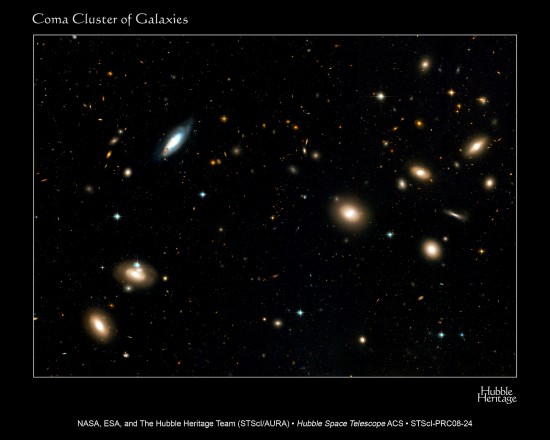
The Coma Cluster. Credit: NASA, ESA, and the Hubble Heritage Team (STScI/AURA). Acknowledgment: M. Carter (Liverpool John Moores University) and the Coma HST ACS Treasury Team.
Jul 15, 2015
A recent press release announces the discovery of so-called “dark galaxies” in the Coma Cluster.
Pieter van Dokkum of Yale University wrote: “On Coma’s outskirts lurk 47 galaxies similar in size to the Milky Way — but with 1,000 times fewer stars. To survive in crowded Coma, these dark galaxies must contain 98% dark matter to hold themselves together, much higher than the fraction in the universe at large (73%).”
It is ironic that this observation involves the Coma Cluster, since it was Fritz Zwicky’s study of the Coma Cluster that showed his calculations for orbital acceleration and stellar mass were off by a factor of about 160. He concluded that there must be something invisible to his instruments somewhere within the cluster that was holding it together. That “something” was later called “dark matter”.
Astronomer Hector Flores said: “Dark matter, which composes about 25% of the Universe, is a simple word to describe something we really do not understand. From looking at how a galaxy rotates, we know that dark matter must be present, as otherwise these gigantic structures would just dissolve.”
In a previous Picture of the Day article about the existence of dark matter, it was noted that it is primarily an add-on to Big Bang cosmology. The Big Bang is supposed to be what brought matter and energy, including gravity, into existence. All modern cosmologists, with few exceptions, accept the theory without question.
It is often written in the popular press that dark matter makes up “25% of the Universe” or that dark energy makes up “75% of the rest of the Universe.” To anyone familiar with plasma physics, it is well known that plasma makes up 99% of the Universe. The amount of gravitational mass invented to save conventional theories is the same as the ionized plasma in an Electric Universe that is overlooked.
Another dark galaxy example, but in the Virgo Cluster, is VIRGOHI 21. It does not shine in visible light. However, hydrogen gas glows in radio waves it was found by a chance scan at the Arecibo Observatory. Dark galaxies are putative evidence for dark matter, since their radiation profiles do not show high enough emissions of electromagnetic energy. Since the Coma Cluster is said to contain 400 times too little luminous matter for it to hold together, dark matter is used to explain almost every anomaly.
Galaxies should exhibit greater density in their cores, gradually fading into unconsolidated boundaries, yet many have rims of tightly knit stars and gas. Some galactic structures, like arms or bars, also reveal almost solid-looking borders. The only explanation found in the scientific press is that gravity acts differently as conditions change. There is no mention of electricity and its powerful fields and forces. Only dark matter is allowed to account for “mysterious” observations.
Electric Universe proponents think that 99% of the Universe is plasma, so the major premise in any analysis must be based on the activities of electricity in space. The forces generated in plasma can easily overwhelm gravity. Dark matter is an excuse for the failure of gravitational theories.
Laboratory experiments demonstrate that galactic structure and angular momentum are predictable results when plasma interactions are considered. If electricity is taken into account, the need for ad hoc addenda to gravity models would be unnecessary. It is not the galaxies but the theory that would “just dissolve” if the data were considered objectively.
Stephen Smith












